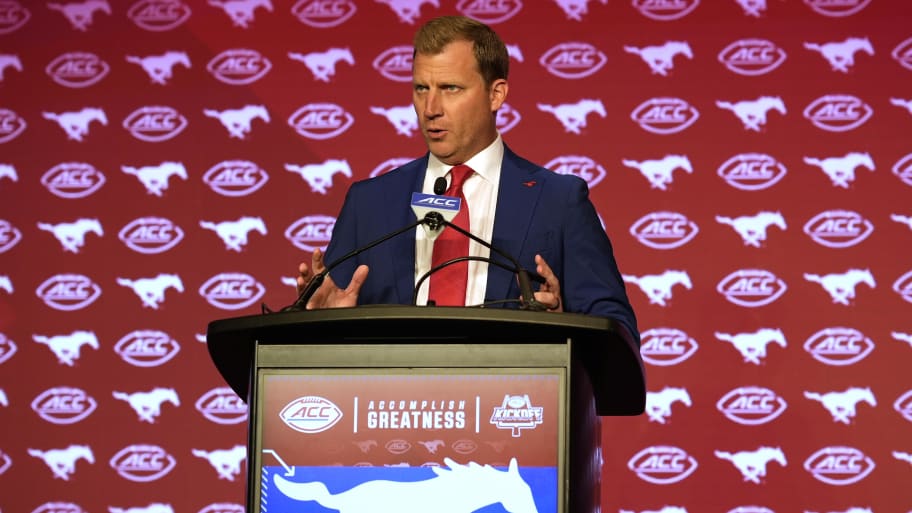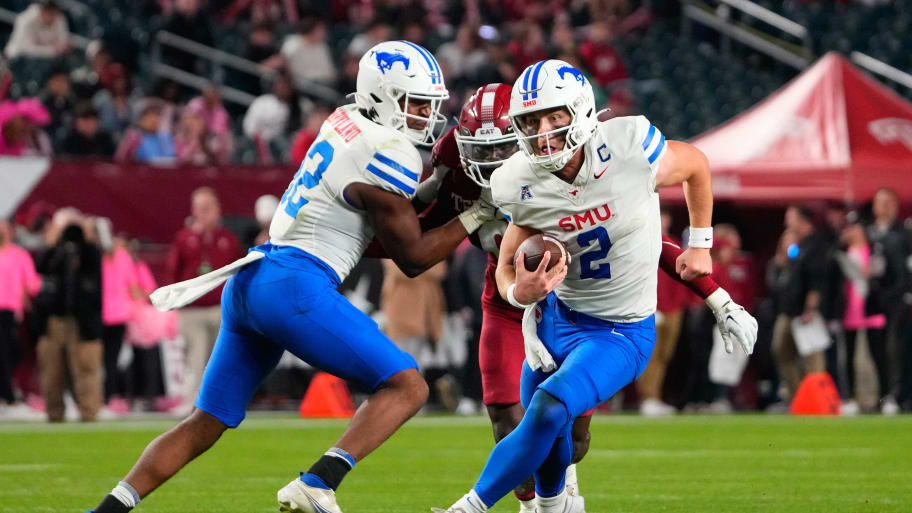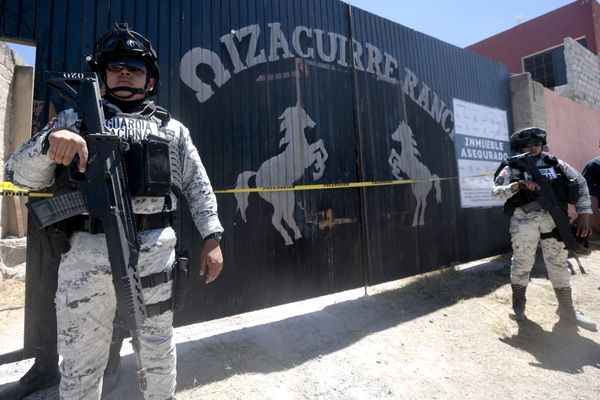
Editors' note: This story was originally published Aug. 23. We are republishing it ahead of SMU's opening-round playoff game against Penn State.
It was move-in day at SMU on Wednesday, an annual frenzy of excited confusion as a new class of students arrived on campus amid withering heat. Bins were being loaded up and packages dropped off and sweaty parents were schlepping belongings into dorms before teary goodbyes were said.
It’s move-in time for the athletic department as well—into the Atlantic Coast Conference. ACC signage has popped up around the idyllic campus in the Highland Park neighborhood of Dallas. On the walls of Moody Coliseum, the Mustangs’ basketball arena, the logos of the other 16 ACC schools are on the walls. It is surreal to behold.
“Gives me chill bumps,” says athletic director Rick Hart as he surveys the new decor.
Saturday at Nevada, SMU plays its first football game as an ACC member, completing a full-circle odyssey in and out and back into the power-conference elite. Left for dead by a football “death penalty” in the late 1980s for repeated NCAA rules violations, then left on the curb after the implosion of the Southwest Conference in the 1990s, this is a comeback nearly 40 years in the making. It required persistence, some arrogance, riding out a string of predatory moves by other leagues—and a Texas oil gusher of booster money.
SMU is the first school to buy its way into a power conference, and it is unapologetic about doing so. The Mustangs simply did what they had to do to get back to where they once belonged. Now the euphoric return to The Club is at hand.
“It’s just an incredible moment,” Hart says. “There were fans that remember the Southwest Conference days that were in tears when the ACC thing came to happen.”
It came to happen just less than a year ago, Sept. 1, 2023, when ACC members voted 12–3 to add the Stanford Cardinal and California Golden Bears from the disintegrating Pac-12 and SMU as the well-heeled tagalong from the American Athletic Conference. This was a marriage of convenience bordering on desperation—the Bay Area schools were facing athletic obsolescence, and the stagnating ACC needed to take action amid a changing landscape.
And then there was SMU, which had a few things to offer: a revived football team and some other successful programs; a solid academic reputation and school profile that fit with the rest of the league; a foothold in talent-rich Texas; a geographic middle ground of sorts between the coasts; and a willingness to forego about $200 million in league revenue over the first nine years of membership. (SMU still is going to make more conference money from the ACC than it did with the American, via other funding sources. But none of that will be media-rights revenue.)
Incurring that kind of revenue deficit is nightmare fuel for athletic directors, but super-rich alumni had Hart’s back. In the seven days after the ACC announcement, $100 million in donations rolled in from 30 boosters who formed what came to be called the First Week Society.
All told, SMU athletics raised $159 million in the 2023–24 fiscal year. That total included four eight-figure gifts, 35 seven-figure gifts and 82 six-figure gifts. It was a staggering outlay that underscored how tightly boosters are woven into the fabric of college sports in Texas, and how competitive they are between schools.
The names of SMU’s heavy hitters are inscribed on several facilities. Armstrong Fieldhouse, where the football team was practicing in an air-conditioned environment while move-in day raged outside, is named for Bill Armstrong, who was the lead donor for the $25 million facility. Garry Weber contributed a record single gift of $50 million to the $100 million end-zone complex at Gerald J. Ford Stadium—that will open Sunday, when the Mustangs go back to work after their opener in Reno. (Conversation in Hart’s office at the opposite end of the stadium was interrupted Wednesday by constant beeping as the new fire-alarm system was being tested in the new building.)
And then there is David Miller, a septuagenarian oil billionaire who put both money and manpower into the power-conference quest.
Miller, who is chairman of the SMU board of trustees, has given generously to both academic and athletic projects at his alma mater. His name is on the basketball court in Moody Coliseum, and his fingerprints are all over the ACC coup. He tirelessly networked on SMU’s behalf with three different conferences: the Pac-12, the Big 12 and the ACC, which at the outset seemed like the most remote landing spot. By private plane and by phone, Miller was the back-channel communicator who conveyed SMU’s selling points—and SMU’s ardor.
“David’s on record saying he’s not worried about us foregoing the media rights and raising the money because largely he had assurances from the people who would need to step up if we got this done,” Hart says. “He said, ‘If we’re in, don’t worry about it.’ ”
The SMU donor cadre stepped up because it could, but also because it must. They acutely understood the chasm that exists between being in the power-conference club and being excluded. They’ve lived both realities, and while on the outside they watched their rivals enjoy everything The Club has to offer.
“For our school, for our fan base, for the SMU family, you can’t really put words on it,” football coach Rhett Lashlee says. “I remember last year on Sept. 1, there was a lot of grown adults just crying. They were here back when Eric Dickerson was playing and they went through the last 30 to 40 years. There seems to be a cool sense of appreciation.
“We had it for 75 years in the Southwest Conference, yet then you had it taken away. There’s a different level of appreciation and gratitude for the opportunity to be back where we feel like our program belongs.”
The old SWC was both everything that’s right and everything that’s wrong about college football. It was fiercely fun, full of great players and colorful coaches, with deep reservoirs of school pride on the line every week among neighbors and colleagues. It also was rife with excess, the pride sometimes turning so toxic that winning overrode everything else.
Which is why the cheating became rampant, and SMU was the cheatingest of the cheaters. (Or, perhaps, just the one that was caught most red-handed.) After winning seven SWC titles before 1950, the Mustangs spent the next several decades watching Texas and Arkansas take over. Then they got their under-the-table donor-giving into high gear, returning to prominence and winning league titles in ’81, ’82 and ’84. The ’82 team went 11-0-1 and finished second in the polls, though the school lays claim to a rather suspect national title from that season.
The NCAA wound up investigating at least half the league, with SMU standing out as repeat rules violators. That led to the two-year shutdown of the team in 1987 and ’88, the first and only “death penalty” punishment handed out to an FBS football program. The university moved to de-emphasize athletics in the aftermath, and a small, private school with a small fan base was an easy exclusion when the Big 12 was formed via a merger of the Big Eight and four from the SWC.
Thus began SMU’s humbling trek through the mid-major wilderness. There were affiliations with multiple leagues, and multiple attempts to get into something bigger and better. The Big 12 twice rebuffed the Mustangs, adding insult to injury by taking in fellow SWC cast-offs and in-state rivals TCU in 2012 and Houston in ’23.
The TCU dynamic was especially painful, and don’t underestimate how much motivation that provided SMU to get back to the power-conference level. The two small, private, religious-affiliated schools are Dallas-Fort Worth metroplex neighbors and ancient rivals, having played 102 times since 1915.
When TCU nearly made the four-team College Football Playoff in 2014, SMU doubled down on its attempts to get into a new league. And when TCU stole SMU’s coach, Sonny Dykes, in late ’21 and then made the playoff in ’22, the Mustangs’ determination spiked.
“I think TCU’s success and the path that they took and where it led them served as a motivator, and maybe even—I don’t want to call it a blueprint, but look, there are a lot of similarities institutionally,” Hart says. “You can be angry about it and want to get there. Or you can look and say, well, if they can do it, we can do it. We are in Dallas, and if we do it, we can be successful because they’ve been successful and we feel like we have greater assets than they do. So that’s the way I choose to look at it.”
There is some unquestionable Dallas cultural snobbery toward Fort Worth, the old cowtown located 30 miles to the west. But there also is this truth: There are simply more high-level football prospects in the Dallas area than in Fort Worth. (Like, for instance, current Mustangs quarterback Preston Stone, who grew up an SMU fan and turned down many offers elsewhere to stay home.) So SMU does indeed have some baked-in advantages.

Miller, the oil billionaire, was criss-crossing the country selling that SMU story to power-conference commissioners. The most receptive was Pac-12 boss George Kliavkoff, who came to Dallas for a Mustangs basketball game in early 2023. With the Pac-12 in need of expansion with the impending loss of USC and UCLA to the Big Ten, SMU and San Diego State looked like locks.
Instead, everything went south. Rather than expand, the Pac-12 imploded in early August last year. SMU looked like it would be stuck in the AAC in perpetuity—but Miller’s relationship building had at least laid a foundation with ACC commissioner Jim Phillips. He wanted to bring in Stanford and Cal, but SMU climbed onboard with a sell job that was too advantageous to pass up.
“I think when Stanford and Cal got in the mix, it was like they’re almost going to need us [too],” Hart says. “I mean, just to bridge the gap geographically. We could really have an important role to play in the future of the ACC.”
Now the future is here. Lashlee, an up-and-coming star coach who took SMU to an 11–3 record and AAC title last year, is in his third season. So are his offensive and defensive coordinators. Stone and many other key contributors were retained through the offseason, while line depth was added to withstand the rigors of a more competitive conference.
“We haven’t done 10 in a row [high-caliber opponents] in 28 years,” Lashlee says. “I think of the 20 transfers we brought in, 13 of them are offensive and defensive linemen. We were wanting quality, but we were also wanting depth. And we try to educate our guys that it’s different. Whereas last year if we played really well, there was probably two games—like Memphis and Tulane—we were going to have to play well to win. We got to play well now just to be in the game in the fourth quarter, whether we’re up a score, down a score, and so we got to prepare to finish tight, close games into the third and fourth quarter.”
The inaugural ACC game will be at home, Sept. 28, against defending league champion Florida State. The Mustangs will have to get by BYU and TCU before then, but both games are at home as well, and they could be 4–0 when the Seminoles arrive.
It will be an emotional scene for the old guard that saw the program rise and fall, and then be kicked out of The Club. SMU is back now, after an improbable and expensive gambit paid off. Of all the schools changing conferences this season, the Mustangs should be the happiest in their new home.
This article was originally published on www.si.com as Persistence and Money: How SMU Returned to a Power Conference 40 Years Later.






